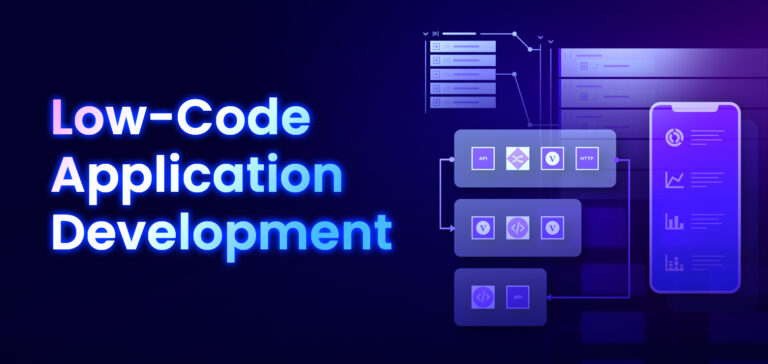Top News On Choosing application development with Low-code platforms
Wiki Article
Advantages Of Low-Code Application Development In Terms Of Integration Capabilities
Integration of low-code applications offers a variety of advantages, such as the ability to seamlessly integrate different applications and systems. These are the main advantages: Pre-built Connectors and APIs
A Wide Variety of Connectors The Low-code platforms typically come with an array of connectors that are pre-built for the most popular enterprise applications (e.g. databases, CRMs ERPs, cloud-based services, and more). This makes it easier to integrate with these systems.
API Integration: Many low-code platforms come with API integration features, allowing developers to connect to other service and data sources easily.
Easy to Use:
Integration via Drag and Drop Integration tasks are usually accomplished by using drag and-drop interfaces. Developers and non-developers are able to set up complex systems that integrate without having to write code.
Visual Workflow builders Visual Workflow Builders utilized to design workflows, data flow, and integrations. They help with understanding and setting up workflows more efficiently.
Standardized Integration Methods:
SOAP and restful services that support web-based services common protocols such as REST or SOAP makes integration easy with many different software and systems.
OData, Other Standards Support for standards such as OData facilitates the access and manipulation data across platforms and applications.
Real-Time Data Synchronization:
Real-Time Integrations: Low-code platforms can handle the real-time synchronization between data applications, systems as well as databases. This will ensure that all data is current and consistent within an organization.
Event-Driven Architectures: Certain platforms provide event-driven architectures that enable applications to react in real-time when certain events happen, which is vital for applications that are dynamic.
Legacy System Integration:
Interconnecting old Systems and New Systems Low-code platform often provides the tools needed to integrate with old systems. This allows companies to modernize their IT Infrastructure without overhauling the existing systems.
Data Migration Tools: Built-in software helps transfer data from older applications to the latest ones developed on platforms that have low-code.
Third-Party Integration of Services:
Cloud Services Integration: The seamless integration of cloud services, such as AWS Azure, Google Cloud makes it easy to deploy and scaling up of applications.
Business Application Integration: Low-code platforms can integrate with different business software like Salesforce, SAP, Microsoft Dynamics and more. to create a seamless workflow that spans different business functions.
Simplified data management:
Data models that are unifying: A few platforms offer low-code support for unified models of data to make data management easier across platforms.
Data Connectors Pre-configured data connectors allow you to easily access and manipulate data gathered from various sources.
Security and Compliance:
Secure Integrations: Low code platforms guarantee that integrations adhere to security protocols as well as standard, protecting data during transport as well as at rest.
Compliance Features: These platforms usually contain features that ensure integrations comply with regulatory requirements (e.g. GDPR, HIPAA), providing assurance for companies handling sensitive data.
Extensibility:
Custom Codes and Scripts. To meet more intricate requirements in integration, low-code platform typically allows for the integration of custom code and scripts. This gives flexibility but without compromising user convenience.
Plug-in Ecosystem : An ecosystem of extensions and plugins allows integration to be enhanced through allowing users to easily implement new functions as they are needed.
The overall low-code platform's integration capabilities makes it an effective tool for creating interconnected applications that are scalable and efficient. They streamline the process of connecting disparate systems, enhance the flow of information, and allow companies to make use of existing technologies while adopting new ones, thereby ensuring an integrated and cohesive IT environment. Take a look at the best Low-code Platform for application development for more advice including rapid app development, sso azure, cross platform mobile app development, application modernization, azure sql, rapid application design, mobile app development platforms, software for app development, azure sql server, push notifications and more.

The Advantages Of Low-Code Development In The Areas Of Governance And Security
Low-code applications offer a number of benefits in terms of security and governance, both of which is essential to ensure that the application is compliant, secure, and well-managed throughout their entire life cycle. These are the primary advantages.
Unified Management console: Low-code platform usually provides a central dashboard for administrators to oversee and manage all applications, ensuring consistency governance across the entire organization.
Role-Based Access Control: These platforms have robust control based on roles that lets administrators define rules and enforce these policies. Only authorized users are able to modify or access certain elements of a program.
Compliance and Regulatory Application:
A lot of low-code platforms come with built-in security features for compliance. They are built to comply with the requirements of industry standards and regulations, such as GDPR or HIPAA. They offer tools and frameworks to help ensure that applications meet these requirements.
Audit Trails and Logging Comprehensive logs and audit trails can be integrated to enable companies to monitor changes in access, and monitor access and the compliance.
Improved Security Measures
Data encryption. Low-code systems offer encryption for information both in the state of rest and while it's being transferred to ensure that sensitive data is protected.
Security Certificates: A lot of low-code providers have a security certificates (e.g. ISO 27001 and SOC 2) which demonstrate that they are adhering to strict security standards. They offer an additional level of assurance to clients.
Automated security updates:
Regular Patching and Updating Lowcode platforms generally manage regular security updates. These patches safeguard software from the latest threats without requiring the involvement of developers.
Security Monitoring Tools: These tools provide alerts in real-time and insights into security concerns that might be present.
Data Governance
Data Access Policies These systems permit organisations to create data access policies and enforce them, ensuring the data is only accessible to those who have been granted access. They also ensure that the data is used correctly.
Data Masking and Anonymization: The built-in tools for masking data and anonymization protect sensitive information, especially in development and testing environments.
Consistent Management of the lifecycle of an application
Development and Deployment pipelines: Lowcode platforms typically provide integrated pipelines for development and deployment that include security checks. They guarantee security throughout the entire lifecycle of an application.
Version Control: An integrated version control allows for the control of changes. It also guarantees that all changes to the software can be tracked, and if needed, reversed. This helps maintain the integrity of the software.
User Authentication, Authorization and Authorization
Single Sign On (SSO): Supporting single sign on and other advanced authentication methods simplifies user management while enhancing security.
Multi-Factor Authentication A number of platforms come with built-in functionality for multi-factor verification, providing an additional layer for security.
Policy Enforcement and Compliance Monitoring:
Low-code platforms usually come pre-defined with policy templates to help organizations implement security and governance policies swiftly.
Compliance Monitoring Tools - These tools permit constant monitoring of compliance status and provide the ability to report, making it easier to identify and resolve any issues that might arise.
Integration into Existing Security Infrastructure
Seamless Integrate: Low-code platform are designed to integrate seamlessly with the existing security infrastructure and tools, including identity management tools SIEMs (Security Information and Event Management Solutions), and firewalls.
API Security: Integrated API security ensures integrations with external system are secure. Protect data and maintain the application's consistency.
Training and best practices
Best practices: Many platforms provide guidelines for the development of secure applications and provide best practices. This can help non-developers comply with security standards.
Certain lowcode companies offer resources and security training for users to understand how to build and maintain secure applications.
Overall, the governance and security benefits of low-code development assure that the applications are developed and managed in a secure, compliant, and controlled way. These platforms provide all the tools and frameworks needed to protect sensitive data and enforce policies, while ensuring regulatory compliance. Take a look at the top Legacy application modernization with Low-code hints for website advice including azure sql, build with docker, app development platform, azure sql server, app platforms, app dev platform, cross platform mobile app development, developing mobile apps, develop web application, app development platform and more.
Low-Code Apps Can Provide Benefits In Terms Of Collaboration And Workflow
It is a good choice for businesses that want to increase team productivity, streamline processes and improve collaboration. Here are a few of the main benefits: Improved cross-functional collaboration:
Unified Development Environment (UDE): Low-code platforms offer an integrated development environment that allows everyone in the team including developers as well as business analysts to collaborate effectively. This helps to eliminate the silos that exist and encourages better communication.
Visual Development Tools - The drag-and-drop visual nature of low-code platforms allows people who are not technical to easily participate in the process. This makes sure that the requirements of business are identified and accurately implemented.
Communication Enhanced:
Real-Time Collaboration Features: Many platforms using low-code have real-time collaborative features, including simultaneous editing, comments and instant feedback. These tools facilitate collaboration and cut down on back and forth discussions.
Workspaces shared by teams are able to collaborate in shared workspaces in which they modify and discuss project components. This will ensure that everyone is working towards the same goal and are on the same team.
Streamlined workflow management:
Built-In Project Management Tools: Low-code platforms usually come with integrated project management tools that aid teams in planning to track and manage their development projects. This includes task management, progress tracking and deadline management.
Automating repetitive workflows and tasks can reduce mistakes and manual labor, allowing teams and individuals to focus on more strategic projects and increase efficiency.
Faster iteration cycles:
Rapid prototyping: Low code platforms allow for rapid prototyping, iterative development and quick prototyping, which allows teams to develop applications, test them and refine them in shorter cycles. This provides rapid feedback and improvement.
Support for Agile Development: Using agile methodologies allow teams to be continuously working in sprints. This allows them to adjust and provide small increments to functionality.
Accessibility:
Citizen Development: Low-code platforms give business users the capability to create and modify apps with no coding experience. This frees IT and Development teams of burdens and allows faster responses to business needs.
Training and Onboarding. Intuitive tools and extensive training materials can help a new team members to get their feet wet, improving the overall level of collaboration.
Centralized Documentation, Knowledge Sharing, and Information Sharing
Integrated Documentation: Low-code systems usually include features to create and maintain documents within the platform itself, ensuring that all information about projects is centralized and easily accessible.
Knowledge Repositories. Teams can establish repositories for knowledge, including templates and reusable parts. This will help facilitate knowledge sharing, and reduce duplicate work.
Standardization and consistency:
Standardized Components. Standardization of components across various applications assures uniformity, which makes it easier to work and be understood the team members.
Governance and compliance Frameworks built-in for governance ensure that applications are developed in accordance with the organizational standards, regulations requirements, and quality standards. They minimize the chance of not adhering to regulations and assure that applications meet the requirements of the standards.
Feedback and Improvement Loops
Integrated Feedback Mechanisms Low-code platforms usually have integrated feedback mechanisms, which allow users to provide easy feedback to applications. This can then be incorporated into the development process.
Continuous Improvement: The capacity to rapidly iterate, deploy and change applications in response to user feedback allows them to be aligned with business goals and user demands.
Visualization, Reporting and Analyzing:
Real-time Analytics: In-built analytics and reports provide real-time information about the project's performance, user interaction and progress. Data-driven decision-making is feasible.
Visual Workflow Mapping Visual tools that show workflows and process can assist teams in optimizing their workflow by identifying bottlenecks.
Low-code development of applications is an effective tool for collaboration and workflow. It brings together different teams, streamlines communication, and automates processes. This creates a more collaborative, efficient, and agile development environment that ultimately leads to more effective applications and better aligning with the business objectives.

